RESEARCH
Signs of illness in Kenyan infants aged less than 60 days
Signes de maladie chez le nourrisson de moins de 60 jours au Kenya
Signos de enfermedad en lactantes de menos de 60 días en Kenya
Mike EnglishI, II,1; Mwanajuma NgamaI; Laura MwalekwaI; Norbert PeshuI
IKEMRI/Wellcome Trust Collaborative Programme, PO Box 43640, 00100 GPO, Nairobi, Kenya
IIDepartment of Paediatrics, University of Oxford; and Honorary Consultant, John Radcliffe Hospital, Headington, Oxford, England
ABSTRACT
OBJECTIVE: Little data has been published on the presenting symptoms and signs among ill infants aged <60 days from developing countries. We aimed to describe and evaluate the potential of simple clinical features to identify severe illness among young infants who present to rural district hospitals in Kenya.
METHODS: Standardized assessment tools were designed to record clinical symptoms and signs. Data were collected prospectively on all infants aged <60 days who weighed >1.5 kg and were admitted over an 18-month period. The same data were collected prospectively from infants recruited to a contemporaneous hospital birth cohort who became ill and were assessed and treated as outpatients at the same hospital.
FINDINGS: Data on 467 outpatient consultations and 769 inpatient episodes were available for analysis. These data highlighted the importance of findings in the history, particularly breathing difficulties, abnormal feeding, and abnormal behaviour, as well as clinical signs in the evaluation of young infants. They indicated possible important differences in the panel of signs useful for detecting severe illness in infants aged 06 days and those aged 759 days. They also showed that some simplification of current guidelines that still preserved the sensitivity and specificity for detecting very severe disease might be possible.
CONCLUSION: Simple clinical features may allow distinction between severe and non-severe illness to be made with reasonable confidence. Prospective studies on an adequate scale are needed urgently to provide current integrated management of childhood illness guidelines for young infants with an adequate evidence base.
Keywords: Critical illness; Infant, Newborn, Diseases/diagnosis; Severity of illness index; Infant, Newborn; Infant care/methods; Delivery of health care, Integrated; Practice guidelines; Sensitivity and specificity; Prospective studies; Kenya (source: MeSH, NLM).
RÉSUMÉ
OBJECTIF: Rares sont les données publiées sur les signes et symptômes qui motivent une consultation, dans les pays en développement, chez les nourrissons de moins de 60 jours. Notre objectif est de décrire et évaluer la possibilité d'identifier grâce à des critères cliniques simples une maladie grave chez les jeunes nourrissons vus en consultation dans les hôpitaux de district du Kenya rural.
MÉTHODES: Des outils d'évaluation standardisés ont été mis au point pour l'enregistrement des signes et symptômes cliniques. Les données ont été recueillies de façon prospective sur tous les nourrissons de moins de 60 jours, pesant au moins 1,5 kg, hospitalisés sur une période d'observation de 18 mois. Les données correspondantes ont été recueillies de façon prospective chez des nourrissons recrutés dans une cohorte de naissance contemporaine, vus et traités en ambulatoire pour maladie dans le même hôpital.
RÉSULTATS: Des données sur 467 consultations en ambulatoire et 769 épisodes avec hospitalisation ont pu être analysées. Elles ont souligné l'importance des antécédents, notamment ceux de difficultés respiratoires, de troubles de l'alimentation et de troubles du comportement, en plus des signes cliniques dans l'évaluation du jeune nourrisson. Elles ont également indiqué que l'éventail des signes permettant de déceler une maladie grave peut être très différent selon qu'il s'agit d'un nouveau-né de 0 à 6 jours ou d'un nourrisson de 7 à 59 jours. Enfin, elles ont montré qu'il devait être possible de simplifier, tout en conservant leur sensibilité et leur spécificité, les lignes directrices actuelles concernant le diagnostic de maladie très grave.
CONCLUSION: Des critères cliniques simples peuvent permettre de distinguer avec une certitude raisonnable une maladie grave d'une maladie sans gravité. Il est urgent de réaliser des études prospectives sur une échelle appropriée afin de disposer d'une base factuelle adéquate à l'appui des lignes directrices actuelles concernant la prise en charge intégrée des maladies du jeune nourrisson.
Mots clés: Maladie grave; Nouveau-né, Maladies/diagnostic; Indice de gravité; Nouveau-né; Soins nourrisson/méthodes; Distribution intégrée soins; Ligne directrice pratique médicale; Sensibilité et spécificité (Epidémiologie); Etude prospective; Kenya (source: MeSH, INSERM).
RESUMEN
OBJETIVO: Hay pocos datos publicados acerca de los síntomas y signos de presentación de los lactantes enfermos de edad inferior a 60 días en los países en desarrollo. Nuestro objetivo consistió en describir y evaluar la posibilidad de identificar enfermedades graves a través de características clínicas simples en lactantes pequeños atendidos en un hospital distrital rural de Kenya.
MÉTODOS: Se crearon instrumentos de evaluación normalizados para registrar los síntomas y signos clínicos. De forma prospectiva, se registraron los datos de todos los lactantes de menos de 60 días con peso > 1,5 kg que fueron ingresados a lo largo de un período de 18 meses. También de forma prospectiva, se registraron los mismos datos en los lactantes incluidos en una cohorte contemporánea de nacidos en el hospital que posteriormente enfermaron y fueron evaluados y tratados en régimen ambulatorio en el mismo hospital.
RESULTADOS: En el análisis se incluyeron los datos de 467 consultas externas y 769 ingresos. Estos datos destacaron la importancia de los hallazgos de la anamnesis, en particular las dificultades respiratorias, los trastornos de la alimentación y los comportamientos anormales, así como de los signos clínicos, en la evaluación de los lactantes pequeños. Asimismo, señalaron posibles diferencias importantes en el conjunto de signos útiles para detectar enfermedades graves en los lactantes de 0 a 6 días y los de 7 a 59 días. También revelaron que es posible simplificar las directrices actuales para detectar las enfermedades muy graves, conservando su sensibilidad y especificidad.
CONCLUSIÓN: Hay características clínicas simples que pueden permitir distinguir las enfermedades graves y no graves con un grado razonable de confianza. Es urgente realizar estudios prospectivos a escala adecuada que proporcionen a la actual atención integrada de las enfermedades infantiles directrices relacionadas con los lactantes pequeños que estén basadas en datos científicos apropiados.
Palabras clave: Enfermedad crítica; Enfermedades del recién nacido/diagnóstico; Indice de gravedad; Recién nacido; Cuidado del lactante/ métodos; Entrega integrada de atención de salud; Entrega integrada de atención de salud; Pautas prácticas; Sensibilidad y especificidad; Estudios prospectivos; Kenya (fuente: DeCS, BIREME).
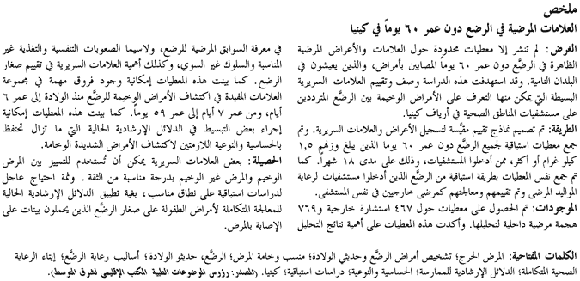
Introduction
Many developing countries have adopted the integrated management of childhood illness (IMCI) approach to the care of ill children at primary care level (1). For assessment, classification, and treatment purposes, children are divided into three age groups: 06 days, 1 week60 days, and 259 months (2). The features of the illness episode and clinical signs that best support appropriate treatment and referral for children aged 260 months were evaluated extensively during the evolution of IMCI from previous disease-specific approaches and the development of the integrated approach itself (3). For children aged 1 week60 days, however, expert opinion and data from a WHO multicentre study on the aetiology of invasive bacterial disease in this age group provide the main basis for the inclusion of symptoms and signs in IMCI tools (46). For infants in the first week of life, in particular, little information has been published on the frequency or potential value of different clinical features that might be used to identify severe illness. To address this problem, we prospectively collected data from two contemporaneous research projects at a single Kenyan rural district hospital to describe the pattern of symptoms and signs in ill young infants and evaluate their usefulness for identifying children with severe disease.
Methods
The study was undertaken at Kilifi District Hospital. This is the main government inpatient facility for a population of more than 500 000 people, although most admissions come from a population of about 200 000 people who live within 30 km of the hospital. Most of the adults are subsistence farmers, with families living in scattered rural homesteads. Transmission of malaria occurs throughout the year, with seasonal peaks in MayAugust and DecemberJanuary after the rainy seasons. The background seroprevalence of HIV is estimated to be 11% in the township that surrounds the hospital and 9% in rural antenatal attendees (7).
Between November 1999 and October 2001, a hospital-based birth cohort study was conducted by the Young Infant Study Team (YIST). The main purpose of this study (described in full elsewhere (8)) was to quantify the nature and burden of life-threatening disease in the first months of life. In brief, mothers who gave birth to infants in the hospital and lived within approximately 30 km of the hospital were asked to allow collection of follow-up data at times of routine infant immunization in Kenya (6, 10, and 14 weeks). To optimize detection and diagnosis of illness episodes, parents were given access to a free outpatient clinic run by research staff during the follow-up period (a routine consultation at the hospital outpatient clinic for a child then cost 20 Kenyan Shillings (about US$ 0.3)). Parents, however, did have to pay any transport costs. A precoded, standardized assessment form that included the symptoms and signs used in the IMCI guidelines (Table 1) was used by clinical staff for all consultations about ill infants, but the diagnosis and treatment were at the discretion of the attending clinician and were not suggested by formal guidelines. For the purposes of this analysis, only illness episodes that did not coincide with a routine immunization visit were included, as it was felt these would be more representative of routine treatment-seeking behaviour. Multiple presentations by the same infant were included in the analysis, although at least seven days had to elapse between episodes with a different diagnosis and at least 14 days between episodes with the same diagnosis. A dataset that comprised illness episodes not severe enough to warrant admission was considered to reflect outpatient infant episodes. Infants admitted from this clinic were included in the dataset of inpatient infants for our study.
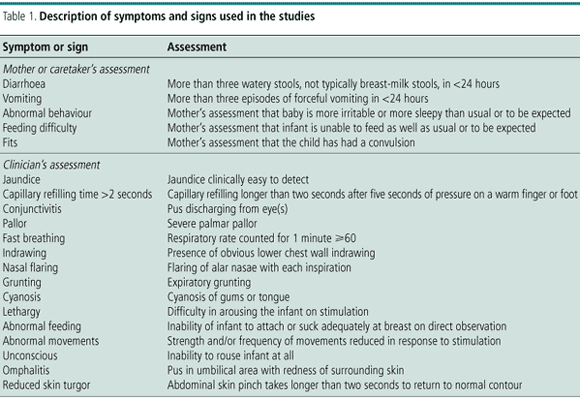
Between November 1999 and April 2001, YIST also undertook a ward-based surveillance study to define as accurately as possible the causes of admission and death in this age group. All infants who were admitted to the hospital aged <90 days were eligible for enrolment, irrespective of place of birth or area of residence. This study has been described in full elsewhere (9). A precoded, standardized questionnaire that included the same symptoms and signs as the outpatient questionnaire was used in the admission assessment, with diagnosis at the discretion of the admitting doctor, who had access to a range of simple diagnostic tests (including full blood count, blood culture, lumbar puncture, and chest X-ray (9)). The only signs assessed in inpatient infants that were not documented on outpatient infant assessments were cyanosis and unconsciousness, as these would demand immediate admission. For the purposes of analysis, these two signs were considered absent in all outpatient infants. Throughout both studies, YIST was responsible for training clinicians in the assessment of young infants to ensure consistency in the definition of symptoms and signs for outpatient and inpatient infants. Treatment was provided in accordance with local and national guidelines (10), and it altered as appropriate during the admission under supervision of a consultant paediatrician (ME).
For the purposes of this analysis, several, non-overlapping groups were defined on the basis of the outcome and progress of inpatient infants:
Infants with definite signs of very severe illness, irrespective of the length of admission, were defined as those who died or those who survived but had one or more of hypoxaemia on admission (oxygen saturation <90% on air), consolidation on chest X-ray (when performed), positive blood culture or positive cerebrospinal fluid culture.
Infants who did not meet these criteria and required inpatient therapy for more than two days were considered to have truly warranted admission.
Infants admitted for <2 days who were discharged well were considered, for the purpose of this analysis, to comprise a borderline group for which admission may or may not have been truly warranted.
These criteria represent a modification of those used in the WHO multicentre study used in the development of the IMCI guidelines (5). Infants who weighed <1.5 kg were excluded from the analysis, because any such infant who presented with a history of illness was likely to be admitted.
The frequency with which each symptom or sign evaluated was observed is described for all three inpatient groups and those well enough to be treated as outpatients. After outpatient infants were excluded and the inpatient outcome groups were reduced down to two categories (those with and those without very severe disease), associations with very severe disease were explored by calculating univariate odds ratios. To further explore which signs might be most valuable for detecting very severe disease, logistic regression models that took account of likely colinearity between signs and those that favoured signs for which a complete dataset was available were constructed. Signs identified as likely to be associated independently with very severe disease were grouped, and the sensitivity and specificity of the presence of any one of these signs for detecting very severe disease were estimated with a dataset that included data on inpatient and outpatient infants. All data were double entered and verified with Foxpro software (version 3.1; Microsoft, Redmond, WA, USA) before analyses were performed with Stata software (version 6; Stata Corporation, College Station, TX, USA). Ethical approval for both studies from which the data was drawn was granted by the Kenyan National Ethical Review Committee.
Results
Births within the defined cohort represented about 15% of those within the district during the study period (unpublished data). From within this cohort of 2189 live births (8), we recorded 467 unsolicited outpatient consultations and treatment episodes for ill infants aged <60 days; 32 of these involved infants aged 06 days. The main clinical problems identified in these outpatient infants were acute respiratory infection (38%), skin infections (14%), and conjunctivitis (8%). No other specific diagnosis accounted for more than 3% of cases, while in 23% of cases, no specific diagnosis could be made. None of the outpatient infants died within 14 days of their assessment. Inpatient surveillance provided data from 759 infants; 297 of these were from infants aged 06 days. Mortality among inpatients was 32% in those aged 06 days and 7% in those aged 760 days. The diagnoses and outcomes for inpatient children have been described in full elsewhere (9). Table 1 and Table 2 show the prevalence of symptoms and signs at the time of presentation in children grouped by our clinical classification, which serves as a proxy for severity of illness. A measured temperature <35.5 ºC, omphalitis, sunken eyes, and reduced skin turgor were each present in <6% of infants in any category in those aged 759 days. Among children aged 06 days, diarrhoea, pallor, sunken eyes, and a bulging fontanelle were each present in <5% of infants in any category.
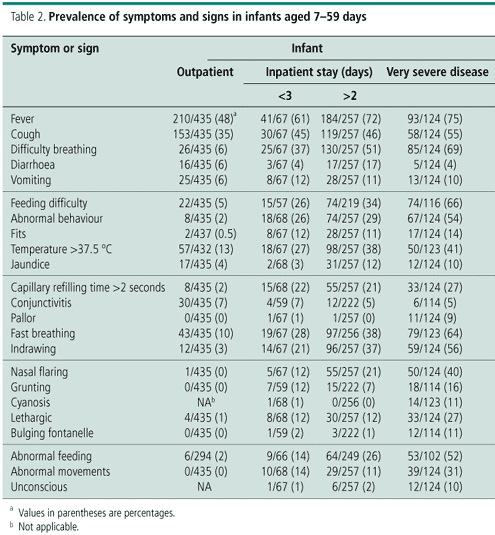
Definition of a group of infants at high risk of invasive bacterial disease for whom broad-spectrum antibiotic therapy is indicated is problematic even in developed countries. Current IMCI case management approaches to the assessment and classification of ill infants attempt to achieve this for children aged 759 days by using many of the clinical features examined here. Table 3 shows univariate odds ratios for the association of these signs with the presence of very severe illness among only inpatient infants. A history of feeding difficulty and the presence of pallor, cyanosis, a bulging fontanelle, or unconsciousness were associated strongly with very severe disease (odds ratio (OR) >3.5), with confidence limits that excluded the likelihood of no association. A history of difficulty breathing or abnormal behaviour or the presence of fast breathing, indrawing, nasal flaring, grunting, lethargy, abnormal suck, or abnormal movements were associated moderately strongly with this outcome (1.5 < OR < 3.5).
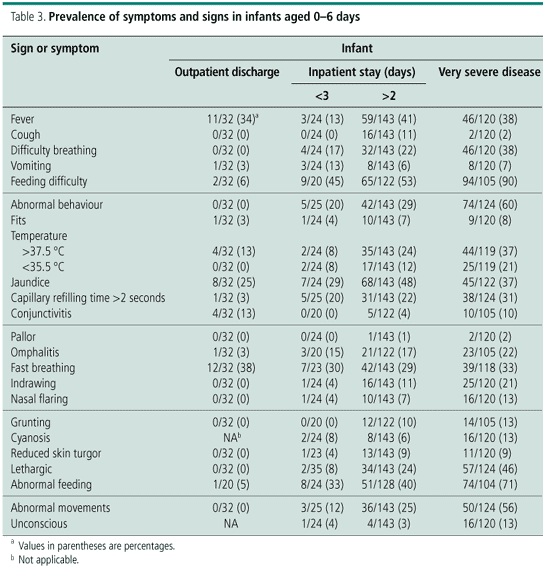
Inclusion of these signs in a multivariate model suggested that a history of feeding difficulty OR 2.8, 95% confidence interval (CI) = 2.65.0), abnormal behaviour (OR 3.1, CI = 1.75.6), breathing difficulty (OR 1.8, CI = 0.93.5), presence of fast breathing (OR 3.1, CI = 1.85.3), indrawing (OR 2.4, CI = 1.34.7), cyanosis (OR 25.8, CI = 1.9354), or a bulging fontanelle (OR 1.9, CI = 3.039.9) were the most likely independent associations with very severe disease among infants aged 760 days. Adoption of the same approach for infants aged <7 days indicated that a history of feeding difficulty or abnormal behaviour, presence of abnormal suck, abnormal movements, or unconsciousness were associated strongly with very severe disease (OR >3.5). A history of difficulty breathing, a measured high or low temperature, or the presence of indrawing or lethargy were associated moderately strongly (1.5 < OR < 3.5)) with very severe disease. In regression models, a history of feeding difficulty (OR 7.3, CI = 3.116.8), breathing difficulty (OR 2.1, CI = 1.02.6), cough (OR 0.1, CI = 0.020.5), or abnormal behaviour (OR 2.4, CI = 1.24.6) or the presence of a fever (OR 3.2, CI = 1.76.3) or indrawing (OR 3.0, CI = 1.18.2) seemed to be associated independently with very severe disease.
Clearly, the ideal screening tool for identification of very ill infants would have high sensitivity and specificity. Current IMCI guidelines for infants aged 759 days suggest that the presence of any one of 16 clinical features in an outpatient infant needs assessment at the first referral level. The sensitivity and specificity of the presence of any one of these 16 signs for the detection of very severe illness in this age group were 97% and 44%, respectively, among the group of patients for whom we had data. This compares with sensitivity and specificity of 96% and 56%, respectively, if only the seven signs identified by the logistic regression model were used as screening signs. No current, agreed guidelines exist for infants aged <7 days. Among infants aged <7 days in this study, the sensitivity and specificity for the group of 16 IMCI signs suggested for use in older infants were 94% and 25%, respectively, and for the six signs identified in the age-specific multiple regression model were 94% and 40%, respectively.
Discussion
Disease in young infants in resource-poor countries remains a relatively neglected topic, despite the fact that mortality in early infancy may comprise a significant fraction of total childhood mortality (11). In our hospital, infants aged <60 days represent 11% of admissions but 35% of inpatient child deaths. Case management, now widely accepted as a key component of strategies to reduce child mortality (12), has gained increased prominence with the introduction of IMCI. The guidelines for assessment, classification, and treatment of children aged 2 months4 years are the product of many years' research in many locations. On the other hand, the guidelines for infants aged 759 days have been based largely on expert opinion and the results of the WHO multicentre study into the aetiology of severe infection in this age group, and they have not yet been evaluated prospectively (4, 13). For infants aged <1 week, the evidence that underlies draft recommendations is limited.
Our data thus provide new and important descriptive background information on the characteristics of young infants as they present for care in a rural district of Kenya. The data suggest that a more restrictive set of signs (a history of feeding difficulty, abnormal behaviour, or breathing difficulty and the presence of fast breathing, indrawing, cyanosis, or a bulging fontanelle) in infants aged 759 days may be as useful as the current extensive list at identifying infants with very severe disease. The presence of at least one of these signs was 97% sensitive and 56% specific for very severe illness. This has important implications if the complexity of guidelines is to be reduced. In the same way, it may be possible to consider the use of a similar small panel of signs for infants in the first week of life. Our findings suggest that a history of feeding difficulty, breathing difficulty, cough, or abnormal behaviour or the presence of a fever or indrawing may detect reliably those infants most in need of hospital-based interventions. In this age group, the presence of at least one sign was 94% sensitive and 40% specific for probable severe illness. These data broadly are compatible with a recent reanalysis of the WHO multicentre young infant study for predictors of neonatal sepsis (6). Thus, six of nine key predictors identified among all infants aged 060 days in that analysis might be considered comparable to potentially useful predictors in this study. Results were discordant for delayed capillary refill, convulsions, and grunting in the WHO study and a history of breathing difficulty, cough, and the presence of a bulging fontanelle in our study. These differences may have arisen as a result of differences in patient selection, disease pattern, definition, or interpretation of symptoms and signs.
Although our data are encouraging, a number of potential limitations must be considered. Mortality in this age group is high. Signs that identify infants with very severe disease may not necessarily be the most useful for detecting the early stages of an illness during which prevention of death might be more achievable. Although we set out to describe the presentation of infants to this hospital prospectively with a common, predefined list of clinical features, we were unable to conduct a comprehensive cross-sectional study of all infants who presented to outpatients. Instead, a comprehensive survey of inpatients was conducted, while outpatient data was collected from infants enrolled in a contemporaneous birth cohort study. Although demographic, socioeconomic, and outcome characteristics for the population recruited to the birth cohort study were comparable with more nationally representative population-based data (8), all of the infants were born in hospital. They thus might not reflect adequately the pattern of disease or clinical features in the total outpatient population of ill young infants, most of whom are born at home, and this may have introduced bias. Such bias certainly might account for the sparse numbers of observed outpatient episodes in those aged <7 days and suggests caution in interpretation of our data.
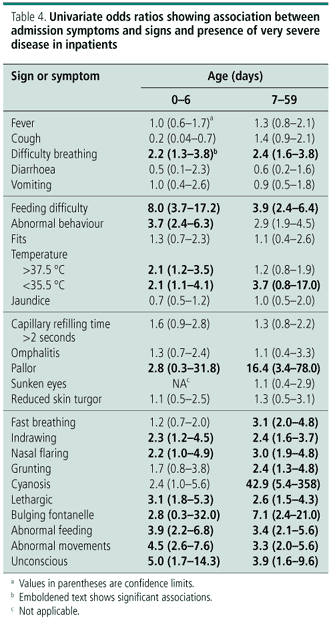
Another difficulty is in the definition of very severe disease among a group of largely inpatient infants. Following the approach taken in the WHO multicentre study of severe infection in young infants (4, 5), we included confirmed invasive bacterial disease, consolidation on chest X-ray, hypoxaemia, and severe anaemia (common in older infants in our setting (14)) as indicators of probable severe disease. It might be argued that any infant in hospital has severe disease. We chose a more restrictive definition to define a group that unequivocally required hospital-based treatment likely to include broad-spectrum antibiotics. Any screening tool must at least identify this group adequately. This choice of definition may explain, however, the relatively low estimated specificity of screening with the clinical features observed.
Conclusion
Although our study has limitations, very few data have been published on the clinical characteristics observed in ill young infants in sub-Saharan Africa. Such data are needed to inform the design of improved, prospective evaluations of possible case-management strategies in this age group a much neglected area of research and to inform debate on possible Kenyan adaptations of current and future guidelines. 
Acknowledgements
This manuscript is published with the permission of the Director of KEMRI. The authors would like to thank all staff of KEMRI and Kilifi Hospital who took part in the Kilifi Birth Cohort and Young Infant studies.
Funding: This project was supported KEMRI and the Wellcome Trust (UK). Mike English is a Wellcome Trust Career Development Fellow in Clinical Tropical Medicine (050563).
Conflicts of interest: none declared.
References
1. World Health Organization. Integrated management of childhood illness. Geneva: World Health Organization; 2002. Available at: URL: http://www. who.int/child-adolescent-health/integr.htm
2. World Health Organization. IMCI Model Handbook. Geneva: World Health Organization; 2000.
3. Gove S. Integrated Management of childhood illness by outpatient healthworkers: technical basis and overview. Bulletin of the World Health Organization 1997;75 Suppl 1:7-16.
4. WHO Young Infant Study Group. Methodology for a multicenter study of serious infections in young infants in developing countries. Pediatric Infectious Diseases Journal 1999;18 Suppl:S8-16.
5. WHO Young Infant Study Group. Clinical prediction of serious bacterial infections in young infants in developing countries. Pediatric Infectious Diseases Journal 1999;18 Suppl:S23-31.
6. Weber MW, Carlin JB, Gatchalian S, Lehmann D, Muhe L, Mulholland EK. Predictors of neonatal sepsis in developing countries. Pediatric Infectious Diseases Journal 2003;22:711-6.
7. Ministry of Health. AIDS in Kenya. Nairobi: Ministry of Health and the National Aids Control Council; 2001.
8. English M, Muhoro A, Aluda M, Were S, Ross A, Peshu N. Outcome of delivery and cause specific mortality and severe morbidity in early infancy a Kenyan district hospital birth cohort. American Journal of Tropical Medicine and Hygiene 2003;69:228-32.
9. English M, Ngama M, Musumba C, Wamola B, Bwika J, Mohammed S, et al. Causes and outcome of young infant admissions to a Kenyan district hospital. Archives of Diseases of Childhood 2003;88:438-43.
10. Government of Kenya. Clinical guidelines. Nairobi: Ministry of Health; 1994.
11. Fikree F, Azam S, Berendes H. Time to focus child survival programmes on the newborn: assessment of levels and causes of infant mortality in rural Pakistan. Bulletin of the World Health Organization 2002;80:271-6.
12. World Bank. World development report 1993. Oxford: Oxford University Press; 1993.
13. WHO Young Infant Study Group. Bacterial etiology of serious infections in young infants in developing countries results of a multicenter study. Pediatric Infectious Diseases Journal 1999;18 Suppl:S17-22.
14. English M, Ahmed M, Ngando C, Berkley J, Ross A. Blood transfusion for severe anaemia in children in a Kenyan district hospital. Lancet 2002;359:494-5.
(Submitted: 3 July 03 Final revised version received: 6 October 03 Accepted: 7 October 03)
1 Correspondence should be sent to Dr English at this address (email: menglish@wtnairobi.mimcom.net).
